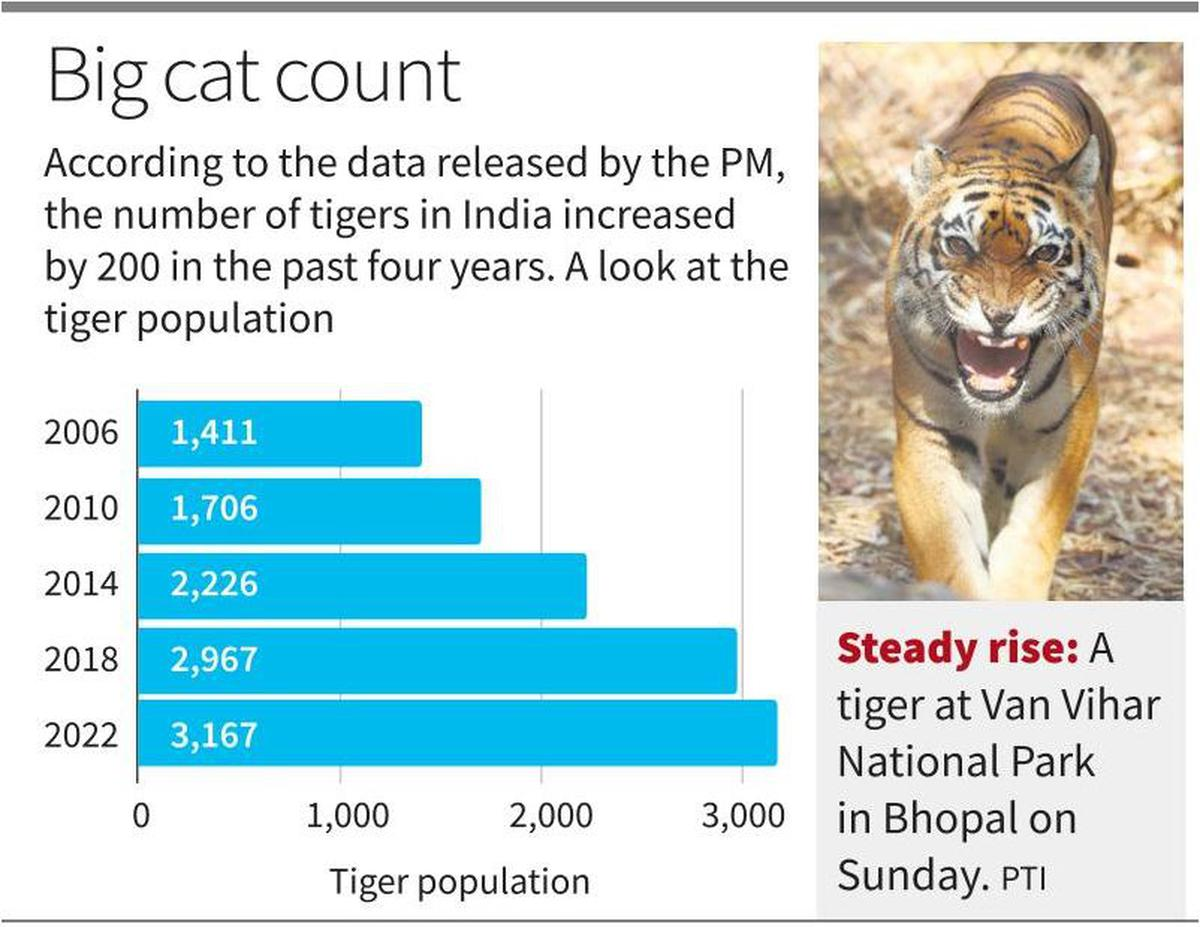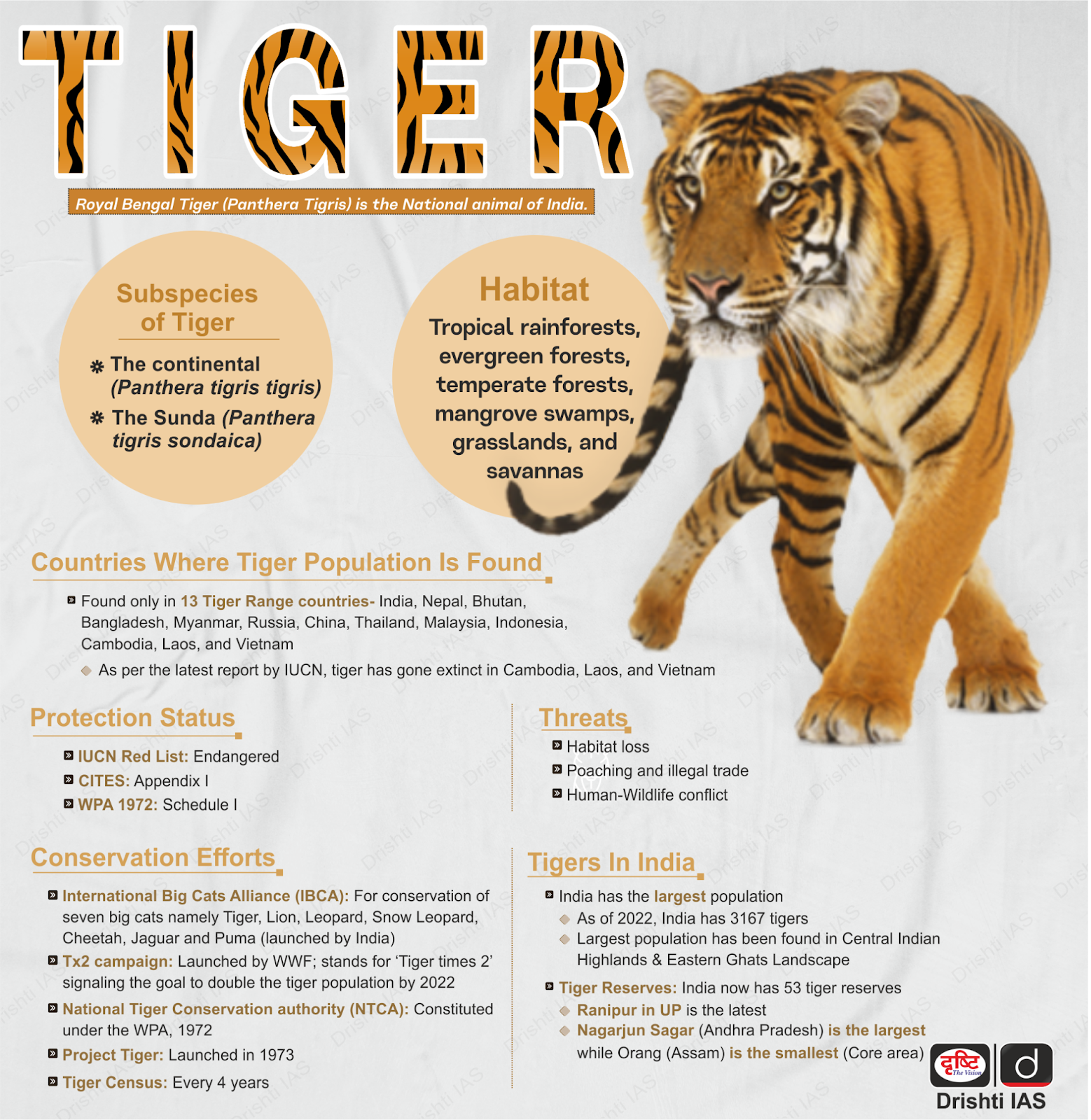Biodiversity & Environment
Global Tiger Numbers Rise, Southeast Asia Faces Habitat Threats
- 15 Nov 2023
- 10 min read
For Prelims: Tiger, Global Tiger Recovery Program (GTRP), United Nations Convention on International Trade in Endangered Species (CITES), International Tiger Day, World Bank, WWF, St. Petersburg Declaration, Tiger Range Countries (TRCs), International Tiger Forum, Global Tiger Initiative (GTI), Tiger Conservation Landscapes (TCL).
For Mains: Issues Countries facing in conservation of wildlife including tigers, Achievements of Project Tiger in India and related learnings, Human-Wildlife Conflict.
Why in News?
Countries have submitted tiger population numbers from 2010-2022 to the Global Tiger Recovery Program (GTRP) and United Nations Convention on International Trade in Endangered Species (CITES) under GTRP 2.0 which aims to pave the way for tiger conservation from 2023-2034.
- The St Petersburg Declaration in 2010 saw 13 tiger range countries commit to reversing the decline of the species population and double their numbers by 2022.
What is the Status of Tiger Conservation in World?
- The wild tiger status is good in South Asia and Russia, but the picture in Southeast Asia is grim, posing challenges to the global tiger population recovery.
- There has been an overall increase in the tiger population by 60%, taking the number to 5,870.
- However, countries like Bhutan, Myanmar, Cambodia, Lao-PDR and Vietnam showed a decline in tiger populations, making the situation “grim” in the Tiger Range Countries (TRCs) of Southeast Asia.
- The success of countries in South Asia like Bangladesh, Bhutan, India and Nepal including China and Russia in North East Asia is attributed to effective measures taken for habitat conservation and protection.
- India's wild tiger population is 3,167 in 2022. Nepal has tripled the tiger population.
What is Global Tiger Recovery Program 2.0 (2023-34)?
- Global Tiger Recovery Programme (GTRP) 2.0 was released at Thimphu on 29 July International Tiger Day 2023 by Minister of Foreign Affairs, Royal Govt of Bhutan.
- GTRP was launched by the World Bank in 2010 under the Global Tiger Initiative (GTI) to double wild tiger populations by 2022, with commitments from Tiger Range Countries (TRCs).
- The Global Tiger Forum (GTF) became the implementing arm for the tiger agenda.
- GTRP 2.0 has been firmed up by tiger range countries through the intergovernmental platform of the Global Tiger Forum along with collaborators like the Worldwide Fund for Nature (WWF).
- GTRP 2.0 emphasizes on strengthening tiger governance, enhancing resources and protection, while addressing contemporary challenges like Human-Wildlife Conflict.
- The new version has retained several ongoing archetypal actions along with new ones for a differentiated approach to save the endangered wild tigers.
What are Threads to the Tiger Population in the World?
- Prey and Tiger Poaching: The situation is said to be challenging in the region due to widespread prey and tiger poaching combined with other lacunae such as inadequate patrolling, poor wildlife monitoring, forest loss for commercial needs, proximity to wildlife trade hubs and rapid infrastructure development resulting in fragmentation.
- Low Investment in Wildlife Conservation: Poor monitoring and low investment in wildlife conservation are other reasons for the drop in tiger populations.
- Habitat Loss and Fragmentation: Habitat loss and fragmentation, along with depleting biodiversity due to anthropogenic reasons among others, is another concern raised threatening the tiger conservation.
- The report observed that loss of forest is a major factors across its ranges, with rapid decline in Southeast Asia.
- Degradation of Tiger Habitat: The tiger habitat has seen degradation due to deforestation, infrastructure development and illegal logging. The report emphasised the need for prey population augmentation in some patches.
What are the Suggestions Given by the Report?
- Need of Genetically Viable Tiger Population: The report stated that, “For a demographically and genetically viable tiger population, steps need to be taken to reverse the current trend of habitat loss, prey depletion and tiger poaching.”
- If steps on tiger stressors are not taken, a majority of the tiger population in Southeast Asia and small populations in parts of South Asia would be lost.
- Address Human-environmental Stress in Tiger Landscapes: The Tiger Conservation Landscapes (TCL) need to be seen from the perspective of an ongoing human-environmental stress continuum.
- There are ongoing agro-pastoral as well as other human-induced modifications in several TCLs. Such stressors impact the availability of welfare factors for major wild herbivores and thereby affect the relative abundance of major carnivores, including the tiger.
- Need a Robust Policy Action: The grim situation demands a robust policy framework supported by political will, long-term availability of resources from the population has increased by 60%, reaching 5,870 individuals.
- However, the report also highlights the challenges and threats faced by the tigers, especially in Southeast Asia, where the situation is grim.
What are Initiatives Taken for Tiger Conservation?
- At Global Stage:
- St. Petersburg Declaration on Tiger Conservation:
- This resolution was adopted In November 2010, by the leaders of 13 tiger range countries (TRCs) assembled at an International Tiger Forum in St. Petersburg, Russia.
- 13 TRCs are: Bangladesh, Bhutan, Cambodia, China, India, Indonesia, Laos, Malaysia, Myanmar, Nepal, Russia, Thailand and Vietnam.
- The resolution’s implementation mechanism is called the Global Tiger Recovery Program whose overarching goal was to double the number of wild tigers from about 3,200 to more than 7,000 by 2022.
- This resolution was adopted In November 2010, by the leaders of 13 tiger range countries (TRCs) assembled at an International Tiger Forum in St. Petersburg, Russia.
- Global Tiger Forum:
- The GTF is the only intergovernmental international body established with members from willing countries to embark on a global campaign to protect the Tiger. It is located in New Delhi, India.
- It was formed on recommendations from an international symposium on Tiger Conservation at New Delhi, India.
- Out of the 13 tiger range countries, seven are currently members of GTF: Bangladesh, Bhutan, Cambodia, India, Myanmar, Nepal and Vietnam besides non-tiger range country U.K.
- Global Tiger Initiative (GTI):
- GTI was launched in 2008 by founding partners the World Bank, Global Environment Facility (GEF), Smithsonian Institution, Save the Tiger Fund, and International Tiger Coalition (representing more than 40 non-government organizations).
- The GTI is led by the 13 tiger range countries. It is a global alliance of governments, international organizations, civil society, the conservation and scientific community, and the private sector committed to working together toward a common agenda to save wild tigers from extinction.
- The GTI Secretariat, based at the World Bank, assists the 13 tiger range countries to carry out their conservation strategies and drive the global tiger conservation agenda, through planning, coordination, and continuous communication.
- St. Petersburg Declaration on Tiger Conservation:
- India:
Conclusion
- While the overall increase in the global tiger population is promising, the challenges faced by Southeast Asian tigers demand immediate attention and comprehensive conservation strategies.
- The collaborative efforts of nations, guided by effective policies and sustained resources, are imperative for ensuring the continued recovery and well-being of this iconic species.
UPSC Civil Services Examination, Previous Year Question (PYQ)
Prelims
Q. Among the following Tiger Reserves, which one has the largest area under “Critical Tiger Habitat”? (2020)
(a) Corbett
(b) Ranthambore
(c) Nagarjunasagar-Srisailam
(d) Sundarbans
Ans: (c)
- Critical Tiger Habitats (CTH), also known as core areas of tiger reserves, are identified under the Wild Life Protection Act, 1972 based on scientific evidence that “such areas are required to be kept as inviolative for the purpose of tiger conservation, without affecting the rights of the Scheduled Tribes or such other forest dwellers”.
- The CTHs are notified by the state government in consultation with the expert committee constituted for the purpose.
- Area of the Core/Critical Tiger Habitat
- Corbett (Uttarakhand): 821.99 sq. Kms
- Ranthambore (Rajasthan): 1113.36 sq. Kms
- Sundarbans (West Bengal): 1699.62 sq. Kms
- Nagarjunsagar Srisailam (part of Andhra Pradesh): 2595.72 sq. Kms
- Therefore, option (c) is the correct answer






